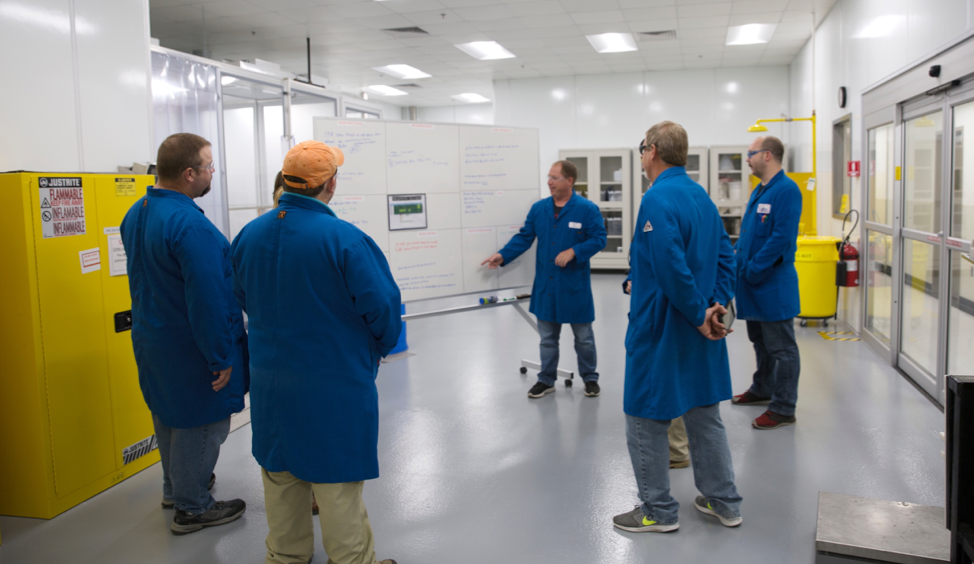If you work outside the manufacturing segment, you may hold old stereotypes about what “factory work” is like. Perhaps you’re picturing a poorly lit, drone-like existence in which you stare at a conveyor belt all day for low pay and little chance of advancement. Or maybe you believe the viable production jobs are now all overseas.
Some of that may have been true a generation or two ago, but the vast majority of manufacturers today no longer resemble your grandpa’s or even your dad’s workplace. The modern manufacturing world offers growing job opportunity, healthy salaries, flexible schedules, benefits, on-the-job training, and enjoyable working environments — often without requiring employees to hold post-secondary degrees.
Let’s examine five prevailing myths about the manufacturing world.
- Manufacturing jobs are all being exported. Though many companies are leaving the U.S., manufacturing jobs as a whole have been increasing in the U.S. According to the National Association of Manufacturers, it is predicted that there will be nearly 3½ million manufacturing jobs needed over the next decade and that due to skills gap there are concerns about finding qualified applicants. In the United States, U.S. affiliates of foreign multi-national enterprises employ over 2 million manufacturing workers.
A recent USA Today article notes that jobs added this year due to foreign investment and re-shoring almost counter those lost to offshoring in 2015. The authors point to recent inbound production shifts from General Electric, Farouk Systems, Ford, Boeing, Caterpillar, Mars Inc. and Flextronic (Apple). “The same market forces that have pushed American jobs overseas are now bringing some of those jobs back,” note Michael B. Sauter and Samuel Stebbins.
Looking ahead, some 3.5 million manufacturing jobs are expected to open in the U.S. between 2015 and 2025 due to economic expansion and baby boomer retirements, with 2 million such jobs requiring specific skills. Displaying the most growth in demand over the next six years will be the construction manufacturing segment, while the Bureau of Labor Services points to current demand for machinists, maintenance technicians, welders, truck drivers, and dispatchers.
- China, is the most competitive manufacturing nation…for now. According to a recent study by Deloitte, “China is ranked as the most competitive manufacturing nation in 2016. However, the US is expected to take over the number one position from China by the end of the decade, while Germany holds firm at number three.”
- Manufacturing jobs always come with low salaries. Actually, the average hourly wage this year was $20.59, equating to $42,827 annually — close to the national average for all U.S. workers whether they hold degrees or not. The U.S. Labor Department recently placed manufacturing on a list of “10 goods jobs that don’t require a degree,” pointing to 17 percent job growth through 2022.
If you hold a degree, your salary prospects are even better. In 2014, new U.S. college grads in the segment started at an average $56,841, compared to $45,473 for all grads that year. This year the median IT manager in manufacturing made $81,843, while manufacturing engineers made a median $62,240.
- Manufacturing work is boring and repetitive. While higher-level manufacturing jobs offer a range of challenges and require various skills, even production-level work can involve science, technology, engineering, math, mechanics, or skilled trades. In many cases robotic machinery has taken over the repetitive tasks, so that open jobs involve more planning and thinking. Over the years there have been significant disruptive changes in manufacturing, as shown in a recent report by the Manufacturing Institute, which are anything but boring and repetitive.
- Manufacturing environments are unpleasant. Sure, production areas are often populated by conveyor belts, assembly lines, robotic equipment, and areas for processing or storing materials. That doesn’t mean they’re dirty, poorly lit, or uncomfortable; in fact, many are subject to more stringent safety and environmental controls than other kinds of businesses due to government regulation. Because employers have a vested interest in keeping you comfortable and healthy on the job, many go out of their way to provide ergonomically correct settings as well as on-the-job employee perks.
Still unable to let go of the stereotypes? Consider touring a local manufacturing plant so you can judge for yourself. After all, a recent article in U.S. News & World Report places part of the responsibility for industry myths on older generations.
“This sector is booming with opportunities for talented, aspiring professionals,” writes Tim Lawrence. “But new research shows parents' misconceptions regarding manufacturing in the U.S. could be holding students back from exploring their potential in this field, as part of their science, technology, engineering and math (STEM) education, and impacting economic growth. The solution is twofold: We need to shatter manufacturing myths and strengthen opportunities in manufacturing education.”




Subscribe to Our Blog